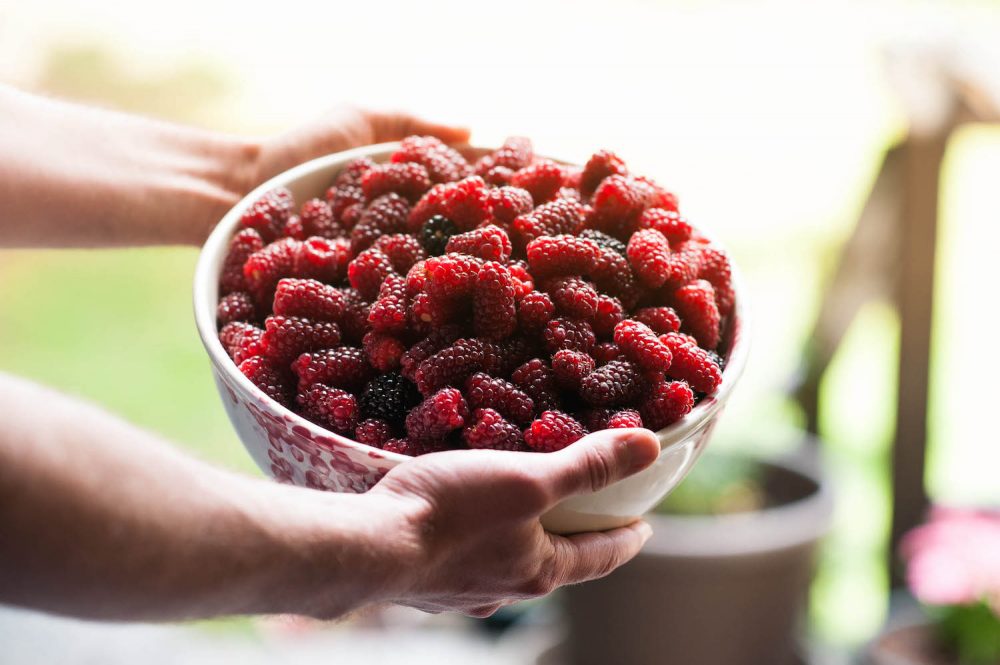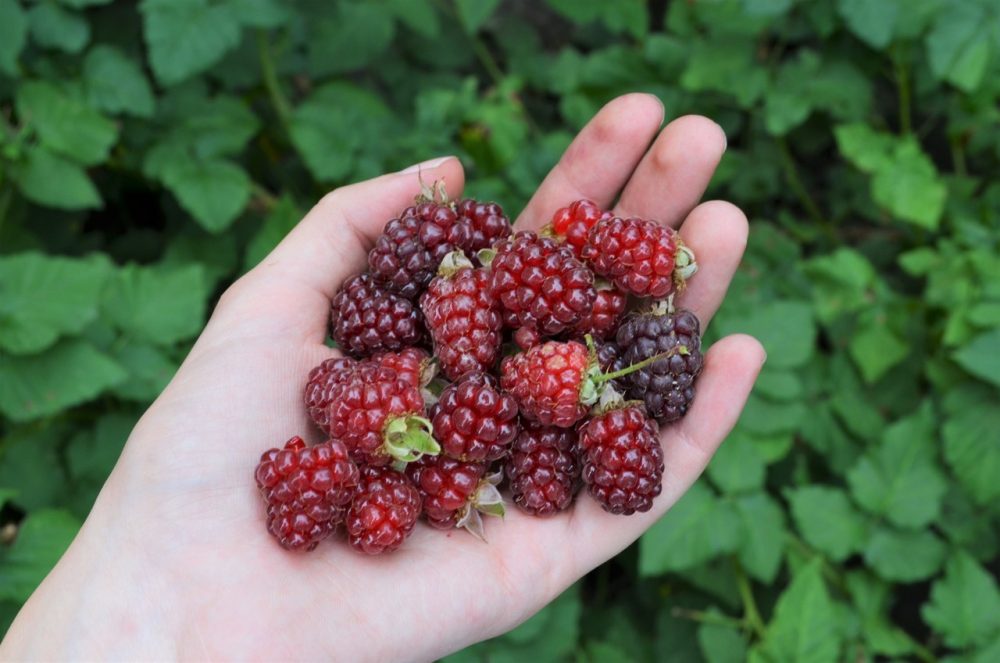28. Tayberries:

These are a cross between a blackberry and raspberry. These are very fragrant and soft berries. They are used to prepare jams.
The tayberry was first developed, in 1962, in Invergowrie (right by the Tay River, thus the name) by David Jennings and David Mason, botanists at the Scottish Crops Institute. This raspberry-blackberry cross produces its fruit in July and August; and the berries are wonderful eaten fresh or cooked into a variety of foods.
A hybrid of the red raspberry and blackberry, tayberries are sweeter and larger than raspberries and very delicate—making them difficult to pack and ship—so they’re only available at farmers markets.
This berry is harvested from early August through early October. Fruit of the tayberry is borne on prickly canes 6 to 7 feet long. They grow well on fences and walls, and are not as prone to pests and diseases as raspberries.
The tayberry has a slightly tart flavor. Fresh tayberries make a great summer pie. They also freeze well up to 1 year. You can make tayberries into a tart-sweet jam, perfect for that peanut butter sandwich or topping on toast. Or try them in smoothies for something a little different.
The tayberry is rich in health benefits. It contains a lot of vitamin C and bioflavonoids as well as being a good source of folate and fiber. Folate and folic acid are forms of a water-soluble B vitamin.
It both tastes and smells just like a blackberry. Taking a bite into one, you may notice that there is a slight tart flavor to it. Fruit of the tayberry are borne on short, strong laterals on prickly canes 6 to 7 feet long. The tayberry fruit, like that of the raspberry and blackberry, is an aggregate fruit consisting of a collection of drupelets. There are many ways that you can enjoy this wonderful, meticulously merged fruit.
A tayberry makes a great pie, which is a wonderful change of pace and is welcome at any late summer picnic. You can make tayberries into a deliciously tart-sweet jam, perfect that peanut butter sandwich or topping on toast.
Try adding tayberries to a bowl of yogurt or ice cream, or incorporate them into fruit salads and smoothies for something a little different. In fact, you can use tayberries anywhere you would ordinarily use blackberries or raspberries.

Tayberries are an exciting addition to your morning cereal, baked goods and of course, they are wonderful just eaten as they are – there’s no wrong answer to the question of how to enjoy these fruits.
For those who like to make wine, the tayberry can be a easy to work with and is certainly an unusual wine to bring to dinner. This wine is delicious and very vibrant red in color. It is a tart, yet sweet wine. You can enjoy it with a beef stew, roast, and other meats such as steak and wild game, such as duck. You can also enjoy it with hors d’oeuvres and a strong cheddar cheese. A bottle of tayberry wine runs about $15. (Learn to make wine at home using tayberries, grapes and other fruit with the The Complete Illustrated Guide To Homemade Wine.)
The tayberry is not just rich in flavor, but has a lot of health benefits to offer. This two-in-one fruit contain a lot of vitamin C and bioflavonoids as well as being a good source of folate and fiber.
Folate and folic acid are forms of a water-soluble B vitamin. Folate occurs naturally in food. Folic acid is the synthetic form of this vitamin that is found in supplements and fortified foods. Folate is necessary for the production and maintenance of new cells. This is especially important during periods of rapid cell division and growth such as infancy and pregnancy. Folate is needed to make DNA and RNA, the building blocks of cells. It also helps prevent changes to DNA that may lead to cancer.
The tayberry fruit and the leaves are a good home remedy for diarrhea. And chewing on the leaves is supposed to help cure bleeding gums.
Tayberry can be used for many things from home remedies to food and wine. It is grown as a cash crop in Florida and New Mexico. You may find it soon growing on a roadside near you. If you find it at your local green grocer, give a try.
A fine source of vitamin C such as Anti-ageing, wound healing, decreasing blood cholesterol and avoidance of infections Assists the body in fascinating iron Bioflavonoid as healthy as being a fine source of folate and fiber Folate is required for the production and maintenance of new cells. This is particularly significant during periods of quick cell division and growth such as childhood and pregnancy It’s important for pregnant women to prevent neural tube defects in the unborn baby The tayberry fruit and the leaves are a good home medicine for diarrhea where chewing the leaves is to help cure bleeding gums
Disclaimer
The Content is not intended to be a substitute for professional medical advice, diagnosis, or treatment. Always seek the advice of your physician or other qualified health provider with any questions you may have regarding a medical condition.